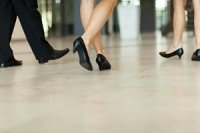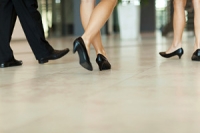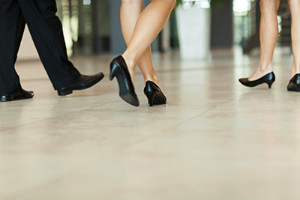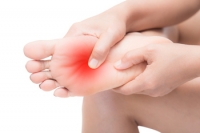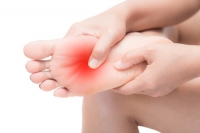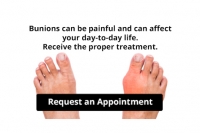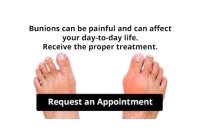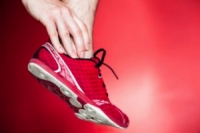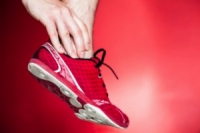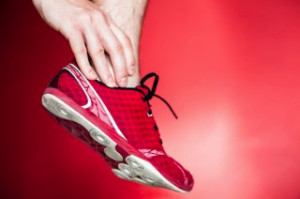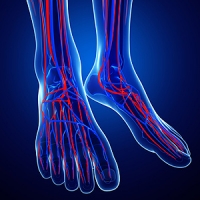
Blog (817)
Two Types of Toe Fractures
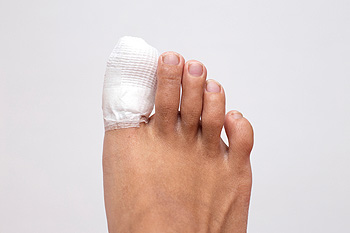 A broken toe is often confirmed by having an X-ray taken. This type of fracture can happen from dropping a heavy object on the toe, or from stubbing the toe against a piece of furniture. There are two categories that the majority of toe fractures fall into, stress or traumatic. A stress fracture can gradually develop, and this typically occurs from repetitive overuse, which may come from running. A traumatic fracture is generally the result of a sudden injury, and can cause severe pain and discomfort. An effective healing process may include buddy taping. This is accomplished by taping the affected toe to the toe next to it, and this is often helpful in providing the necessary support as the affected toe heals. If you have a broken toe, please consult with a podiatrist who can treat this condition.
A broken toe is often confirmed by having an X-ray taken. This type of fracture can happen from dropping a heavy object on the toe, or from stubbing the toe against a piece of furniture. There are two categories that the majority of toe fractures fall into, stress or traumatic. A stress fracture can gradually develop, and this typically occurs from repetitive overuse, which may come from running. A traumatic fracture is generally the result of a sudden injury, and can cause severe pain and discomfort. An effective healing process may include buddy taping. This is accomplished by taping the affected toe to the toe next to it, and this is often helpful in providing the necessary support as the affected toe heals. If you have a broken toe, please consult with a podiatrist who can treat this condition.
A broken toe can be very painful and lead to complications if not properly fixed. If you have any concerns about your feet, contact Dr. Kenneth Donovan from Advanced Care Foot and Ankle. Our doctor will treat your foot and ankle needs.
What to Know About a Broken Toe
Although most people try to avoid foot trauma such as banging, stubbing, or dropping heavy objects on their feet, the unfortunate fact is that it is a common occurrence. Given the fact that toes are positioned in front of the feet, they typically sustain the brunt of such trauma. When trauma occurs to a toe, the result can be a painful break (fracture).
Symptoms of a Broken Toe
- Throbbing pain
- Swelling
- Bruising on the skin and toenail
- The inability to move the toe
- Toe appears crooked or disfigured
- Tingling or numbness in the toe
Generally, it is best to stay off of the injured toe with the affected foot elevated.
Severe toe fractures may be treated with a splint, cast, and in some cases, minor surgery. Due to its position and the pressure it endures with daily activity, future complications can occur if the big toe is not properly treated.
If you have any questions please feel free to contact one of our offices located in Warren, Livingston, and Toms River, NJ . We offer the newest diagnostic and treatment technologies for all your foot and ankle needs.
Solutions to Standing All Day
Do you work on your feet and find yourself in pain by the end of the day? If so, this is not surprising. Standing all day can lead to many complications, including foot pain, plantar fasciitis, muscle fatigue, bunions, swollen feet and ankles, and Achilles tendonitis. While you may not be able to avoid frequent standing completely, there are some steps that you can take to give your feet a break. If possible, try to alternate standing with sitting throughout the day. Walk around, sit in different positions, and move regularly to help disperse your weight more evenly. Wearing comfortable and supportive shoes, special shoe inserts, or compression hose and socks may also help. Finally, performing foot and leg stretches regularly can strengthen your lower limbs and reduce your risk of developing various foot and ankle problems. For more advice on mitigating the foot and ankle complications from working on your feet, consult with a podiatrist today.
While working on the feet, it is important to take the proper care of them. For more information about working on your feet, contact Dr. Kenneth Donovan from Advanced Care Foot and Ankle. Our doctor will treat your foot and ankle needs.
Working on Your Feet
Standing on your feet for long periods of time can cause stress and pain in your feet. Your whole body may experience change in terms of posture, back pain, bunions, callouses and or plantar warts. There are ways to avoid these conditions with proper foot care, smart choices and correct posture.
Positive Changes
Negative heeled shoe – Choosing this shoe type places the heel slightly lower than the ball of the foot. These are great for overall foot health. Find shoes that fit you correctly.
Go barefoot – Our feet were not designed to be enclosed for all hours of the day. Try to periodically expose your feet to air.
Eliminate Pain
Foot Exercises – Performing simple exercises, incorporating yoga and doing stretches are beneficial. This will allow increased blood flow to the area and muscles of the foot.
Achilles tendon – Stretching the foot out flat on the floor will relax the calf muscles and tendon. These exercises can be performed almost anywhere. Make sure you add these exercises to your daily regimen.
With a little bit of this information and knowing more about foot health, you will notice changes. Foot stretches and proper footwear will help with pain and prevent further issues.
If you have any questions please feel free to contact one of our offices located in Warren, Livingston, and Toms River, NJ . We offer the newest diagnostic and treatment technologies for all your foot and ankle needs.
Solutions to Standing All Day
Do you work on your feet and find yourself in pain by the end of the day? If so, this is not surprising. Standing all day can lead to many complications, including foot pain, plantar fasciitis, muscle fatigue, bunions, swollen feet and ankles, and Achilles tendonitis. While you may not be able to avoid frequent standing completely, there are some steps that you can take to give your feet a break. If possible, try to alternate standing with sitting throughout the day. Walk around, sit in different positions, and move regularly to help disperse your weight more evenly. Wearing comfortable and supportive shoes, special shoe inserts, or compression hose and socks may also help. Finally, performing foot and leg stretches regularly can strengthen your lower limbs and reduce your risk of developing various foot and ankle problems. For more advice on mitigating the foot and ankle complications from working on your feet, consult with a podiatrist today.
While working on the feet, it is important to take the proper care of them. For more information about working on your feet, contact Dr. Kenneth Donovan from Advanced Care Foot and Ankle. Our doctor will treat your foot and ankle needs.
Working on Your Feet
Standing on your feet for long periods of time can cause stress and pain in your feet. Your whole body may experience change in terms of posture, back pain, bunions, callouses and or plantar warts. There are ways to avoid these conditions with proper foot care, smart choices and correct posture.
Positive Changes
Negative heeled shoe – Choosing this shoe type places the heel slightly lower than the ball of the foot. These are great for overall foot health. Find shoes that fit you correctly.
Go barefoot – Our feet were not designed to be enclosed for all hours of the day. Try to periodically expose your feet to air.
Eliminate Pain
Foot Exercises – Performing simple exercises, incorporating yoga and doing stretches are beneficial. This will allow increased blood flow to the area and muscles of the foot.
Achilles tendon – Stretching the foot out flat on the floor will relax the calf muscles and tendon. These exercises can be performed almost anywhere. Make sure you add these exercises to your daily regimen.
With a little bit of this information and knowing more about foot health, you will notice changes. Foot stretches and proper footwear will help with pain and prevent further issues.
If you have any questions please feel free to contact one of our offices located in Warren, Livingston, and Toms River, NJ . We offer the newest diagnostic and treatment technologies for all your foot and ankle needs.
The Symptoms of Morton’s Neuroma
Morton’s neuroma is caused by irritation of one or more of the small nerves in the foot, located near the toes. The most frequent symptom of Morton’s neuroma is pain in the ball of the foot that worsens while walking. Other common symptoms include numbness between the toes and a burning sensation. Morton’s neuroma often develops as a result of excessive pressure on the front of the foot, but can also be caused by misalignment of the foot. Sometimes, this condition can have no apparent cause. If you are experiencing the symptoms of Morton’s neuroma, it is stronglysuggested that you visit a podiatrist for diagnosis and treatment.
Morton’s neuroma is a very uncomfortable condition to live with. If you think you have Morton’s neuroma, contact Dr. Kenneth Donovan of Advanced Care Foot and Ankle. Our doctor will attend to all of your foot care needs and answer any of your related questions.
Morton’s Neuroma
Morton's neuroma is a painful foot condition that commonly affects the areas between the second and third or third and fourth toe, although other areas of the foot are also susceptible. Morton’s neuroma is caused by an inflamed nerve in the foot that is being squeezed and aggravated by surrounding bones.
What Increases the Chances of Having Morton’s Neuroma?
- Ill-fitting high heels or shoes that add pressure to the toe or foot
- Jogging, running or any sport that involves constant impact to the foot
- Flat feet, bunions, and any other foot deformities
Morton’s neuroma is a very treatable condition. Orthotics and shoe inserts can often be used to alleviate the pain on the forefront of the feet. In more severe cases, corticosteroids can also be prescribed. In order to figure out the best treatment for your neuroma, it’s recommended to seek the care of a podiatrist who can diagnose your condition and provide different treatment options.
If you have any questions, please feel free to contact one of our offices located in Warren, Livingston, and Toms River, NJ . We offer the newest diagnostic and treatment technologies for all your foot care needs.
The Symptoms of Morton's Neuroma
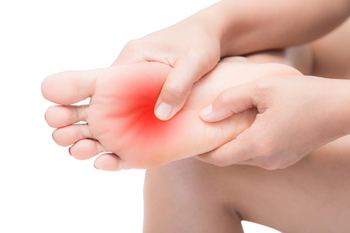 Morton’s neuroma is caused by irritation of one or more of the small nerves in the foot, located near the toes. The most frequent symptom of Morton’s neuroma is pain in the ball of the foot that worsens while walking. Other common symptoms include numbness between the toes and a burning sensation. Morton’s neuroma often develops as a result of excessive pressure on the front of the foot, but can also be caused by misalignment of the foot. Sometimes, this condition can have no apparent cause. If you are experiencing the symptoms of Morton’s neuroma, it is stronglysuggested that you visit a podiatrist for diagnosis and treatment.
Morton’s neuroma is caused by irritation of one or more of the small nerves in the foot, located near the toes. The most frequent symptom of Morton’s neuroma is pain in the ball of the foot that worsens while walking. Other common symptoms include numbness between the toes and a burning sensation. Morton’s neuroma often develops as a result of excessive pressure on the front of the foot, but can also be caused by misalignment of the foot. Sometimes, this condition can have no apparent cause. If you are experiencing the symptoms of Morton’s neuroma, it is stronglysuggested that you visit a podiatrist for diagnosis and treatment.
Morton’s neuroma is a very uncomfortable condition to live with. If you think you have Morton’s neuroma, contact Dr. Kenneth Donovan of Advanced Care Foot and Ankle. Our doctor will attend to all of your foot care needs and answer any of your related questions.
Morton’s Neuroma
Morton's neuroma is a painful foot condition that commonly affects the areas between the second and third or third and fourth toe, although other areas of the foot are also susceptible. Morton’s neuroma is caused by an inflamed nerve in the foot that is being squeezed and aggravated by surrounding bones.
What Increases the Chances of Having Morton’s Neuroma?
- Ill-fitting high heels or shoes that add pressure to the toe or foot
- Jogging, running or any sport that involves constant impact to the foot
- Flat feet, bunions, and any other foot deformities
Morton’s neuroma is a very treatable condition. Orthotics and shoe inserts can often be used to alleviate the pain on the forefront of the feet. In more severe cases, corticosteroids can also be prescribed. In order to figure out the best treatment for your neuroma, it’s recommended to seek the care of a podiatrist who can diagnose your condition and provide different treatment options.
If you have any questions, please feel free to contact one of our offices located in Warren, Livingston, and Toms River, NJ . We offer the newest diagnostic and treatment technologies for all your foot care needs.
Are Bunions Affecting Your Everyday Life?
Are Bunions Affecting Your Everyday Life?
What to Consider When Buying Running Shoes
Whether you are a seasoned runner, or just beginning your running journey, choosing the right running shoe is crucial for avoiding injuries and ensuring that you have a safe, stable, and effective run. With so many different kinds of running shoes on the market, it can be difficult to figure out which type of running shoe you should get. There are several factors to consider when purchasing a running shoe. These include what type of surfaces you plan to run on, how far you plan to run, what your gait is like, and even what socks you will be wearing while you run. You will also need to make sure that the shoes fit properly and provide adequate support for your feet while running. For more information on how to choose the right running shoes for you, consult with a podiatrist.
If you are a runner, wearing the right running shoe is essential. For more information, contact Dr. Kenneth Donovan from Advanced Care Foot and Ankle. Our doctor can provide the care you need to keep you pain-free and on your feet.
Choosing the Right Running Shoe for Your Foot Type
To increase performance and avoid the risk of injury, it is important to choose the right running shoe based on your foot type. The general design of running shoes revolves around pronation, which is how the ankle rolls from outside to inside when the foot strikes the ground.
- Neutral runners are able to choose from a wide variety of shoes, including minimalist shoes or even going barefoot.
- Runners who overpronate, or experience an over-abundance of ankle rolling, should choose shoes that provide extra motion control and stability.
- Runners who underpronate, or supinate, have feet that have high arches and lack flexibility, preventing shock absorption. They require shoes with more flexibility and cushion.
If you have any questions please feel free to contact one of our offices located in Warren, Livingston, and Toms River, NJ . We offer the newest diagnostic and treatment technologies for all your foot and ankle needs.
What to Consider When Buying Running Shoes
Whether you are a seasoned runner, or just beginning your running journey, choosing the right running shoe is crucial for avoiding injuries and ensuring that you have a safe, stable, and effective run. With so many different kinds of running shoes on the market, it can be difficult to figure out which type of running shoe you should get. There are several factors to consider when purchasing a running shoe. These include what type of surfaces you plan to run on, how far you plan to run, what your gait is like, and even what socks you will be wearing while you run. You will also need to make sure that the shoes fit properly and provide adequate support for your feet while running. For more information on how to choose the right running shoes for you, consult with a podiatrist.
If you are a runner, wearing the right running shoe is essential. For more information, contact Dr. Kenneth Donovan from Advanced Care Foot and Ankle. Our doctor can provide the care you need to keep you pain-free and on your feet.
Choosing the Right Running Shoe for Your Foot Type
To increase performance and avoid the risk of injury, it is important to choose the right running shoe based on your foot type. The general design of running shoes revolves around pronation, which is how the ankle rolls from outside to inside when the foot strikes the ground.
- Neutral runners are able to choose from a wide variety of shoes, including minimalist shoes or even going barefoot.
- Runners who overpronate, or experience an over-abundance of ankle rolling, should choose shoes that provide extra motion control and stability.
- Runners who underpronate, or supinate, have feet that have high arches and lack flexibility, preventing shock absorption. They require shoes with more flexibility and cushion.
If you have any questions please feel free to contact one of our offices located in Warren, Livingston, and Toms River, NJ . We offer the newest diagnostic and treatment technologies for all your foot and ankle needs.
Symptoms of Peripheral Artery Disease
Peripheral artery disease (PAD) is a condition that causes poor circulation in the lower limbs due to blockages in the blood vessels that supply blood to this area. The most common symptoms of PAD are pain, numbness, heaviness, or achiness in the leg muscles, especially when walking or climbing stairs. You may also notice a weak or absent pulse in the legs and feet, slow-healing wounds on the feet, a pale or bluish color to the skin, a lower temperature in one leg than the other, poor nail growth on the affected foot, and poor hair growth on the affected leg. However, it is worth noting that many people who have PAD have no noticeable symptoms. For this reason, it is important to receive regular screenings for PAD from a podiatrist, especially if you have certain risk factors, such as being a smoker, or having diabetes, high blood pressure, or heart disease.
Peripheral artery disease can pose a serious risk to your health. It can increase the risk of stroke and heart attack. If you have symptoms of peripheral artery disease, consult with Dr. Kenneth Donovan from Advanced Care Foot and Ankle. Our doctor will assess your condition and provide you with quality foot and ankle treatment.
Peripheral artery disease (PAD) is when arteries are constricted due to plaque (fatty deposits) build-up. This results in less blood flow to the legs and other extremities. The main cause of PAD is atherosclerosis, in which plaque builds up in the arteries.
Symptoms
Symptoms of PAD include:
- Claudication (leg pain from walking)
- Numbness in legs
- Decrease in growth of leg hair and toenails
- Paleness of the skin
- Erectile dysfunction
- Sores and wounds on legs and feet that won’t heal
- Coldness in one leg
It is important to note that a majority of individuals never show any symptoms of PAD.
Diagnosis
While PAD occurs in the legs and arteries, Podiatrists can diagnose PAD. Podiatrists utilize a test called an ankle-brachial index (ABI). An ABI test compares blood pressure in your arm to you ankle to see if any abnormality occurs. Ultrasound and imaging devices may also be used.
Treatment
Fortunately, lifestyle changes such as maintaining a healthy diet, exercising, managing cholesterol and blood sugar levels, and quitting smoking, can all treat PAD. Medications that prevent clots from occurring can be prescribed. Finally, in some cases, surgery may be recommended.
If you have any questions, please feel free to contact one of our offices located in Warren, Livingston, and Toms River, NJ . We offer the newest diagnostic and treatment technologies for all your foot care needs.

